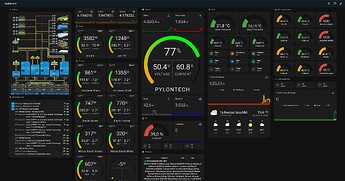Hi all,
up until 2 weeks ago, my system was made of almost 50:50 ac/dc pv, as outlined in my first showroom thread: 3-Phase MP 5000 / 28 kWh Pylontech / 18 kWp Solar (8 DC, 10 AC)
During winter, I always felt like having 10 kWp ACPV is not ideal, as there are times when the battery is not reaching 100%, but buying from grid is also required. That always made me think of the energy I lost due to DC-AC-DC conversion upon charging the battery with ACPV.
Coincidently, I know a super cool company that makes DC-coupled Solarchargers - So, I decided to replace the AC-coupled Fronius with a MPPT RS in order to have more DCPV for increased battery charge efficiency during winter.
The MPPT RS is slightly smaller in it’s capacity than the Fronius was, so out of the 8060 Watts panels (26) connect to it, I could only move 5580 Watts (18 panels) to the RS. For the remaining 2x4 Panels, I hooked up 2 Hoymiles HMT-1600.
This results in a total of 13580 kWp of DC-Solar, which looks a bit high for 3 MP 5000, but knowing the panels have different orientations and 100% Output is achieved rarely I expected that to fit well - and passt two weeks showed that the maximum DC-PV Output was around 12.800 (higher than expected), but the Multis managed to feed in that amount without throttling DC-PV, when the battery is fully charged.
Having ~ 4200 Watts of ACPV left should - during not so sunny days - still be enough to cover my houses AC-needs, so basically all of DCPV could be feed into the battery.
Core-Components:
- 3x Multiplus 5000/48
- MPPT 250 | 70 with 3200 Watts Solar 0°
- MPPT 250 | 85 with 4800 Watts Solar 0°
- MPPT RS 450 | 100 with 5580 Watts Solar, 25° South
- Hoymils HMT-2000 with 1840 Watts Solar, 60° South-East.
- Hoymils HMT-1600 with 1240 Watts Solar, 25° South.
- Hoymils HMT-1600 with 1240 Watts Solar, 25° South.
- Victron EVCS NS
- 8x Pylontech US3000C
Victron-Wall:
Heres a overall picture of what I call the “Victron-Wall” ![]()
DC-Box:
The DC-Busbar is made out of 10x20mm Pure-Copper material, featuring a total of 12 possible Connections. Bars are designed asymmetric so with alternating +/- everything can be connected nearly straight, matching the usually width of a 2 TE Breaker. (However, at the End 1.5TE Breakers, only positive end have been used)
MPTTs and Multiplus are each connected with exactly 1.8m of 35mm², Batteries are connected as 4x2 with 25mm² cabling. Nowadays I would rather use 50mm² here, but temperatures stay within reasonable values during full load - so there’s no immediate need to redo that part.
Each cable is equiped with a 1-Wire DS18B20 to monitor temperatures 24/7. MPPTs got some extra cooling fans, and the whole “DC-Box” is controlled by a wemos d1 mini, sending all values to my local mqtt and controlling fans as required.
The Batteries
8x Pylontech US3000C, 28 kWh capacity, connected as 4x2, have been equiped with a 4mm Child-Protection-Window (you can find and print the holders here: Pylontech US2000/3000/5000 Bracket Child-Protection-Window-Holder by dognose - Thingiverse) - not to protect the child from voltage, but to protect all the buttons and switches from the child ![]()
Solar
Main-Solar is a total of 16 kWp, All Panels made in Germany (Heckert Solar & SolarWatt) arranged as 8 kWp with a 0° angle (You can walk on these, full glas/glas) and 8 kWp 25° South on the upper roof as well as 5 Solar-Thermic Collectors for hot water.
Last Year, I added 1.8 kWp of steep angled (60°) Ja-Solar panels on the muld behind our house to provide some extra-winter-early-morning-boosting ![]()
No Sun…
… no problem. A while ago I decided to build a 2kw Windturbine on my lawn. Well, the expactation on the turbine was more like 500 Watts to extend battery runtime during night - and yeah, that’s about what is possible at best at our local wind-conditions. Never meant to pay back in any way, just wanted to build one ![]()
Finally
I’m a professional Software-Engineer with background in electrical engineering, needless to say that everything in my home that is somehow related to electricity and energy is controlled in some way. In the past year, I transitioned (almost) everything of my Home-IT-Dashboard to HomeAssistant, making maintenance a lot less timeconsuming.
The energy flow is just a super cool visualization, scaling in real time. So messmerizing, I could watch tiny energy bubbles float around for hours ![]()
Stay tuned, I have been asked a lot about this widget since I occassionaly share screenshots of it - And because I migrated the energy flow widget to a HomeAssistant-Card as well, I will share that with the community soonish. (Got to fix some minor flaws)
That’s it from my side - if you have any questions about details, feel free to ask.







